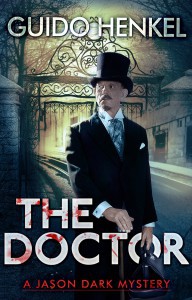What do Alice Cooper and “The Doctor” have in common?
 Those of you familiar with my book “The Doctor, %%% % % % ” or “Dr. Prometheus” as it was previously called, may already know the answer to it, but here’s a little background on my writing of the Jason Dark series.
Those of you familiar with my book “The Doctor, %%% % % % ” or “Dr. Prometheus” as it was previously called, may already know the answer to it, but here’s a little background on my writing of the Jason Dark series.
When I first set out to write the series one of the things I really wanted to include were historical and literary references to create a sense of alternate history rather than just plain gothic horror or supernatural thriller. At the same time I didn’t want to to make it too blatant. I aimed to place them so that they are oftentimes subtle little hints, evident only to the initiated, people familiar with certain periods of history, certain locales or certain pieces of literature or oftentimes even song lyrics. Yes, if you think you’ve spotted a loose reference to a Judas Priest song, you might be absolutely right… Lyrics like “The figure stands expressionless, impassive and alone” are just too powerful images to ignore and they conjure up worlds in my mind that I try to translate to my stories occasionally, giving a nod to the source with a few words that directly hint at their origins.
 More often than lyrics, however, I use references to actual historical events and personalities, as well as literary figures. Anyone who’s been reading “Theater of Vampires” will have noticed a certain person approaching Jason Dark in the foyer of the Duke’s Theater. His appearance instantly begs the question, when will he meet the other guy making up the team? Depending on how far you’ve read through the series, let me just say, he will meet him-first fleetingly in one story-then in a head-on matching of their minds on another further down the line. Fun…
More often than lyrics, however, I use references to actual historical events and personalities, as well as literary figures. Anyone who’s been reading “Theater of Vampires” will have noticed a certain person approaching Jason Dark in the foyer of the Duke’s Theater. His appearance instantly begs the question, when will he meet the other guy making up the team? Depending on how far you’ve read through the series, let me just say, he will meet him-first fleetingly in one story-then in a head-on matching of their minds on another further down the line. Fun…
Assuming most of you are familiar with “Demon’s Night,” the first book in the series, I wonder how many of you remember what happened to the horse carriage the demon abandoned in Trafalgar Square. Do you? A man made a very brief appearance, taking care of the exhausted horses, leading them away, with the demon’s residue still lingering inside the coach. The man’s name was… John Netley. Who is he? Glad you asked, because John Netley was the man who allegedly drove Jack the Ripper through the streets of Whitechapel as he was hunting and killing women in 1888.
BAM!
See what I did there? I wove reality and fiction together in a way that is perfectly harmonious-at least it is to me-because the implications are just too perfect. First I had to do something with the horse carriage. I couldn’t just leave it abandoned in the square, so I needed someone to take care of them. Who better than a young man who would around that time become a coach driver and turn it into his business. With demonic residue still lingering in the coach, it is not too much of a leap of faith that it was this demonic influence that drove the Ripper to do his notorious deeds, and that turned the young man of a driver into a tool of evil, helping with the ghastly murders. It all fell into place and I was able to use the historical descriptions of the Ripper horse carriage to describe the one in my book.
I love it when things fall into place like this and allow me to create seemingly insignificant moments-almost like throwaway paragraphs-that fit into a much bigger and elaborate picture. The books are full of them and the next time you read one of my books try to keep an eye out for these moments and references-and let me know when you spot one. Post here, and share your findings with other readers.
 So, what do Alice Cooper and “The Doctor” have in common? No doubt, you are still asking yourself that question. Even though completely anachronistic, Alice Cooper shows up in the book, but… yes, here comes the but, but before, let me tell you the why. I’ve been a fan of Alice’s work since I was an early teenager, more years ago that I’d like to admit. He’s always been a modern day gothic horror icon to me, the way Boris Karloff, Bela Lugosi, Christopher Lee, Peter Cushing, or Vincent Price were, because his theatrics have always been geared towards the creepy visuals. So, it made sense for me to pay homage to him, and I did. In the form of a corpse. Remember Alice has had many acts in his show where he hangs himself, or gets decapitated, etc, so having him as a corpse made perfect sense. But he is not just any corpse. He is undead, as the Doctor revives him with his evil magic.
So, what do Alice Cooper and “The Doctor” have in common? No doubt, you are still asking yourself that question. Even though completely anachronistic, Alice Cooper shows up in the book, but… yes, here comes the but, but before, let me tell you the why. I’ve been a fan of Alice’s work since I was an early teenager, more years ago that I’d like to admit. He’s always been a modern day gothic horror icon to me, the way Boris Karloff, Bela Lugosi, Christopher Lee, Peter Cushing, or Vincent Price were, because his theatrics have always been geared towards the creepy visuals. So, it made sense for me to pay homage to him, and I did. In the form of a corpse. Remember Alice has had many acts in his show where he hangs himself, or gets decapitated, etc, so having him as a corpse made perfect sense. But he is not just any corpse. He is undead, as the Doctor revives him with his evil magic.
I felt that simply dropping Alice Cooper in the story would be too jarring, the anachronism too stark. It felt too blatant, so I upped the ante and actually included him under his actual name, not his stage persona. Therefore, the character you will find in “The Doctor” is Vincent Furnier-exhumed by grave robbers and reanimated by the Doctor. Here’s a brief excerpt to give you a taste…
Pale and bare-chested, the bloodless corpse of a man lay on the operating table in the center of the room. His skin had an almost yellowish tinge. Unusually long black hair fell to the sides of his head in light, shaggy curls. The eyes, sunken deep into their sockets, looked already like the cavernous orifices of a skull. The body appeared intact, without notable scars; in fact, the dead man’s face had a rather peaceful look, despite the deep shadows cast by the murky, flickering light.
Somewhere in the distance a church bell rang and, joining it in a midnight duet, a dog began to bark.
“Well, Mr. Furnier,” a rich, baritone voice said softly, and a man appeared from the darkness. “Your audience is waiting.”
What do you make of this? It’s only a small portion. The entire scene is filled with references to Alice Cooper and his music. Try to find them, and post them here.
 But what’s more, just to show you how dense some of these injected references are, even that small excerpt above contains yet another reference to something unrelated to Alice Cooper. I challenge you to find it. Tell me where the reference is and what it actually refers to. I wonder if anyone can spot it.
But what’s more, just to show you how dense some of these injected references are, even that small excerpt above contains yet another reference to something unrelated to Alice Cooper. I challenge you to find it. Tell me where the reference is and what it actually refers to. I wonder if anyone can spot it.
Did you get a taste yet? Believe me when I say that the Jason Dark books are filled with these kinds of hidden nods, sometimes very openly, sometimes much more hidden. It is one of the small things that makes writing the stories so much fun for me.
Well, then, who can solve the puzzle? What is the reference I mentioned in the passage above? I can’t wait to hear your thoughts and comments.

Feel free to check out all the books in the Jason Dark series on Amazon, or visit the official website at www.jasondarkseries.com
